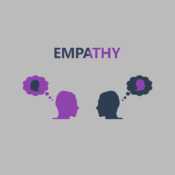From my upcoming book, the “A Practical EmPath” system:
In order to keep it simple and reduce confusion, I’m not going to talk here about the many ways other people define empathy and sympathy. There are many! I’m going to focus on my changing understanding of these concepts and where I’m at now with what’s most important to me: ways of distinguishing between sympathy and empathy so that we can learn, communicate about, and practice their use most clearly and effectively.
Back in 2005 when I first discovered NVC, the interpretation I had from/of the book was that sympathy was to be discouraged, while empathy was the primary basis of NVC. I saw NVC-style empathy as a combination of what psychologists call “affective empathy” and “cognitive empathy”. With the benefit of hindsight, I see that interpretation as useful in my development of getting to where I am now with these concepts.
How does that work?
In the following example, Bob will begin with cognitive empathy and move into a more affective-type empathy. His end goal is to understand Susie’s world, not necessarily to feel what she feels. Let’s see how cognitive empathy can inadvertently lead to affective empathy.
Susie: “Today it really sucked at work.”
Bob (using cognitive empathy – not feeling her frustration yet but instead trying to place himself in the scene so he can understand): “Would you like to share more about that?”
Susie: “Sure. Jim got on my case in our morning meeting about not working over the weekend on the big project.”
Bob (here Bob is still doing cognitive empathy. He’s more imagining what Susie was feeling, rather than actually feeling it, though at this point a person could be imagining it and feeling it): “Oh. When Jim said that in front of your peers, were you embarrassed and angry?”
Susie: “Yes! It was like he was questioning my commitment, integrity, and capability! I got pretty mad and exerted a huge amount of self-control to not cry right there in front of everyone!”
Bob (some part of what she said really clicks for Bob here and he starts feeling for Susie in that situation): “I know how much you value integrity and competency, so I can imagine how much that hurt!” (Bob’s eyes now begin getting wet and he feels a lump in his throat).
Why and when would you want to keep your empathy cognitive rather than allow your empathy to be or become affective?
-
If we are empathizing with a person whose perspective we judge to be toxic to our well-being.
-
If the environment or person would not be well served by bringing more than a minimal amount of emotion into the conversation. Think office environment or business negotiation.
-
If it is easier for us to think/imagine than to feel in that moment. Of course, we may grow most by choosing the course more difficult for us, but for some situations we may choose efficiency before growth.

So when would you want to allow your empathy to become affective?
-
First and foremost, when you want to.
-
The situation and person you are talking with wants the more sympathetic connection because they will feel more trust, understanding, connection, support, etc.
-
It can have many positive effects on you, as the empathizer, including “working your empathy muscles,” increasing your courage, and the positive feelings that can come from liberating and expressing your emotions.











Recent Comments